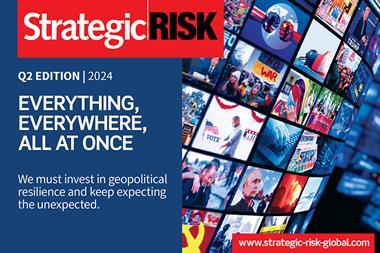Supply chains are particularly vulnerable to climate risk, as many global production systems are focused on ensuring efficiency over resiliency
When Australia’s entire financial sector calls for an institutionally embedded collective target of net zero greenhouse gas emissions by 2050 – as they did in November – you know that things are getting serious on the climate action front.
Yet while awareness and action is on the rise, it is not uniform. A few months earlier, research commissioned by FM Global found that more than three quarters (77%) of CEOs and CFOs of the world’s largest companies admitted their firms are not fully prepared for the adverse financial impact of a changing climate.
That was despite three-quarters of respondents (76%) agreeing that their organisations are somewhat to significantly exposed to climate risk.
To some extent, these admissions of under-preparedness are understandable, given how broad-ranging the impacts of a changing climate are forecast to be. A recent report by McKinsey highlights changes from an increase in average temperatures, to extreme precipitation, stronger and more frequent hurricanes and typhoons, drought, lethal heat waves and threats to water supplies.
The three exposures that most concerned executives surveyed by FM Global were floods, drought and bushfires. These were perceived to likely “most negatively affect their financials.”
From our perspective, the greatest risk when it comes to climate change is complacency. Eight out of 10 executives surveyed (82%) believed their companies have somewhat to no control over the impact climate change has on their business.
Shoring up the climate-threatened supply chain
One key area where climate risk is set to have a significant business impact is supply chains. When a climate-related natural hazard occurs, it can impact suppliers in a number of ways: by hitting core production, sourcing and distribution, financing and risk management and business value.
As just one example, Cyclone Amphan, South Asia’s strongest storm in a decade, affected 15 million people in May, impacting Bangladesh, India and Sri Lanka, and created havoc for many who rely on supply chains in these locations, with COVID-19 further complicating the situation.
Supply chains are particularly vulnerable to climate risk and its intensifying hazards, as many global production systems like supply chains have focused on ensuring efficiency over resiliency. This became very clear during COVID-19.
Businesses looking to fortify their supply chain’s resilience to climate change must start by improving their knowledge about climate risks and how they are managed throughout their supply chain.
Ultimately, the goal is to determine the likelihood of a specific risk materialising, the impact if it does materialise, and preparedness to deal with that risk if it arises – both on their own business’s end and among at-risk suppliers.
Armed with this information, they can make informed decisions about diversifying their most important suppliers or working with them on climate change risk improvements.
Start with a supplier impact analysis
An important first step is to identify all suppliers that your business is highly dependent on for continuity of its operations and commitments to customers. Get clear on what your key products and services are, how much each depends on an individual supplier, and add up all the profits supported by that supplier.
Knowing which suppliers your organisation is most dependent on provides you with an opportunity to focus your attention where the greatest risk lies if any of them were to be impacted by a climate-related event, such as a cyclone, flood or bushfire.
With high priority suppliers at hand, focus on the climate risk each of these suppliers faces in their locations. Rigorous analysis using data-driven risk assessment tools can provide invaluable insights to business executives on which regions, sites and business partners are most vulnerable.
The FM Global Resilience Index is one such tool. It amalgamates data gathered by risk engineers who visit and assess risk factors at more than 100,000 client locations worldwide each year, combining this with information gathered from sources such as the World Bank and International Monetary Fund.
The index allows companies to assess the resilience of countries where suppliers are based, or where new suppliers may be established, by twelve core drivers, across three areas - Economic, Risk Quality, and Supply Chain.
Armed with these details, organisations can drill down to discover how much of an overlap there is between suppliers they are most dependent upon, and those who are most at risk.
On the ground assessment
If you decide it is still important to work with suppliers who face a significant level of risk, a thorough review of the effectiveness of a supplier’s business continuity plan (BCP) is an important way to grasps whether suppliers are taking adequate steps to mitigate risks they may face in the event of a natural disaster.
On site risk assessments by risk consultants is another way to get to know your key suppliers’ climate risk level and preparedness. These take into account local flood studies, location topography, suitability of construction to resist common natural hazards such as winds, flooding, bushfire and more and may be used to make a final call on whether you cut ties with a supplier, or work with them to strengthen their resilience.
Climate risk may be unpredictable, but businesses are far from having no control over its effects. Rigorous analysis of priority suppliers – and potential alternatives – using data-driven tools and expert partners will increase the chance that your supply chain can continue to deliver the goods for your business, come rain or shine.
Michael Stuckings is operations chief engineer at FM Global




















No comments yet